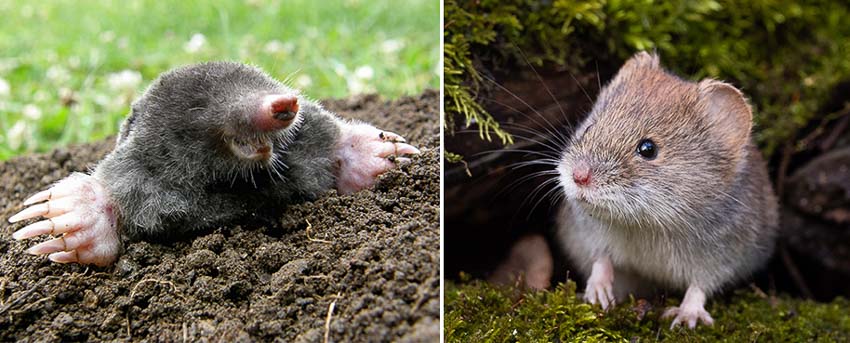Moles and voles have a lot of similarities, and it can be hard to tell which animal is causing damage to your lawn and garden. Learn how to tell the difference between a mole and vole by discovering more about their habits and the damage they cause.
What are Moles and Voles?
Moles and voles are both small, burrowing animals. Although they possess many similar characteristics, they are quite different in how they live and feed. People often mistake moles and voles for each other, but there are several ways to tell them apart.
If you’re experiencing problems with moles or voles, it’s important to know which one you’re dealing with to develop the proper control strategy. Both types of pests can cause extensive damage to your lawn and garden, and their presence can be a nuisance.
Their behaviors, habitats, and distinctive features can help you determine which one you’re dealing with.
Introduction to Moles: Habits and Features
Unlike voles, identifying what is a mole can be tricky because they are not rodents. They are mostly insectivorous, but they do eat some plants, which essentially makes them omnivores.
Their closest relative is the common shrew.
You can find moles on every continent except Antarctica and South America.
They make their homes in various habitats, including meadows and grasslands. They probably avoid acidic soils and mountainous terrain because they need help finding enough food in those habitats.
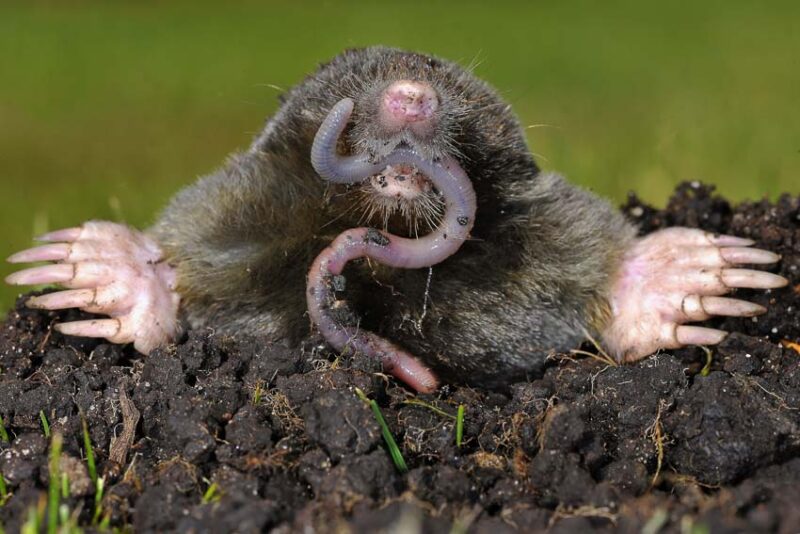
Moles feed on grubs and worms.
Their saliva contains a toxin that can paralyze earthworms. They often collect earthworms and keep them alive but contained in the chambers of their tunnels.
Scientists have found thousands of earthworms collected by moles in one spot.
Moles breed in February through May, and they have a gestation period of about 42 days. Three to five young are born in each litter, and after about 33 days, the babies leave the nest to find their own territory. The following spring, they are ready to reproduce, and they live about three to five years.
Introduction to Voles: Habits and Features
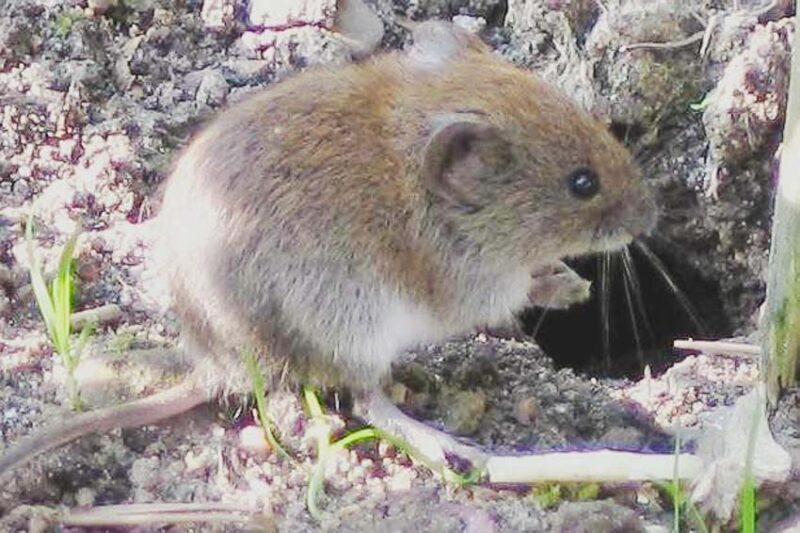
Due to their resemblance to mice, voles are often called meadow mice, but their closest relatives are hamsters and lemmings.
You can find voles in grasslands, meadows, and riparian areas throughout North America, Asia, and Europe.
They eat a wide variety of plants, especially grasses. At the end of summer, they store seeds, grains, and tubers, and during the winter, they eat bark and stored food. Occasionally, voles eat insects and snails.
Like other rodents, voles breed throughout the year, having up to five litters each year. Their gestation period is 21 days, with each litter producing an average of three to six young.
By the time they are 21 days old, the young are ready to leave the nest, and they reach sexual maturity at 35-40 days. Voles have a much shorter lifespan than moles, usually at most 16 months.
Key Differences and Similarities between Moles and Voles
Understanding the key differences and similarities between moles and voles makes it easier to tell them apart.
Distinguishing Physical Features of Moles and Voles
What is the difference between a mole and a vole? Although they are similar in size, you can use the following features to identify them.
Nose, Eyes, and Ears
Moles are well adapted to spending life underground digging holes. They have a long sensitive, pointed snout, and their eyes and ears are so small they aren’t visible.
Voles look like mice, with blunt, rounded snouts, large black eyes, and rounded ears.
Teeth
Teeth are another distinguishing feature.
Like all rodents, voles have prominent, chisel-shaped front teeth made for chewing. Since moles aren’t rodents, they don’t have the characteristic sharp front teeth that all rodents have.
Size and Shape
Moles and voles are very close to the same size, about four to eight inches long, but moles are slightly smaller. Moles are cylindrical, while voles are shaped more like mice. They both have shorter tails, which is one of the easiest ways to tell voles from field mice.
Fur
When it comes to fur, moles have soft, velvety fur that doesn’t have a grain, meaning it appears the same whether it’s brushed forward or backward. This feature allows moles to move backward and forward underground without resistance.
Conversely, voles have dense underfur covered with longer guard hairs that grow toward the posterior.
Feet
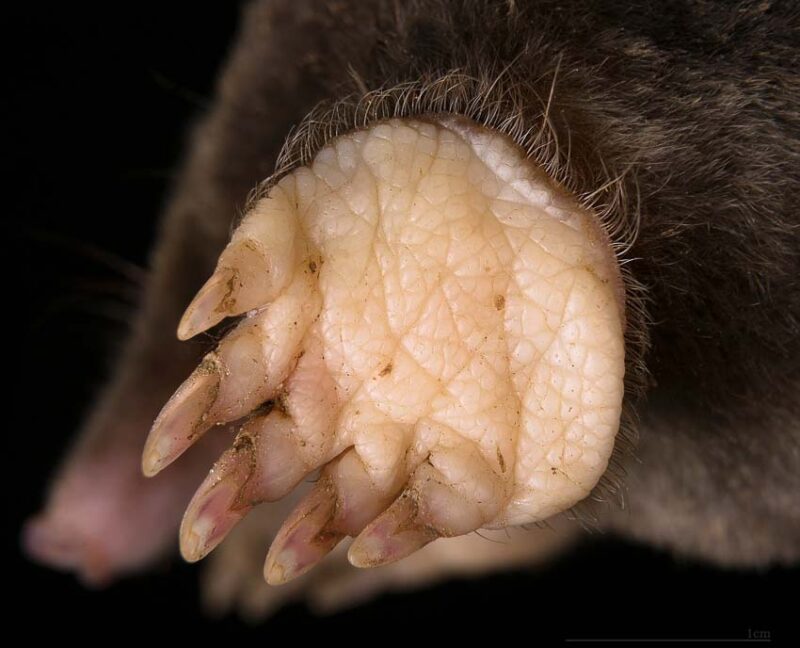
The most remarkable feature of moles is their large front claws. Their front feet are paddle-shaped and turned inwards for digging. Moles are also polydactyl , meaning they have an extra thumb, known as a prepollex.
Voles have feet similar to mice, and their tracks often identify them. The front tracks have four pointed toes, and the rear tracks have five.
Behavioral Differences and Similarities between Moles and Voles
Moles are fossorial animals that spend most of their life underground, digging tunnels and chambers. Their feet, bone structure, and fur are adapted for digging. Voles are semi-fossorial, meaning they live part of the time underground.
Moles and voles can both cause extensive damage to your lawn and garden. They are both active during all times of the day and night, though they often are most active at dusk and dawn to avoid predators and humans.
One of the biggest differences between moles and voles is what they eat. While moles are omnivorous, voles are herbivores, primarily eating plants, grasses, and roots.
Another significant difference between moles and voles is that moles tunnel underground, while voles are surface tunnelers.
Moles and voles do not hibernate. They are relatively active all year round. While moles continue to live underground all year, voles may build temporary nests under the snow during the winter.
How to Identify Moles and Voles in Your Garden
Both moles and voles cause damage to your lawn and garden as an incidental result of tunneling. Since you rarely see moles and voles unless you catch them, identifying them by the signs they leave behind is often easier.
Learn more about the typical signs of mole and vole infestations.
Understanding the Typical Signs of a Mole Infestation
Both moles and voles are tunnelers, but moles are the diggers of the two. While moles sometimes nibble on plant roots, most of the damage they cause to plants happens incidentally in their hunt for insects, grubs, and earthworms.
They dig tunnels all over your yard and garden, leaving mounds of fresh dirt. Although moles help gardeners by eating grubs and aerating the soil, the damage they cause with their tunnels can be disastrous in a lawn or garden.
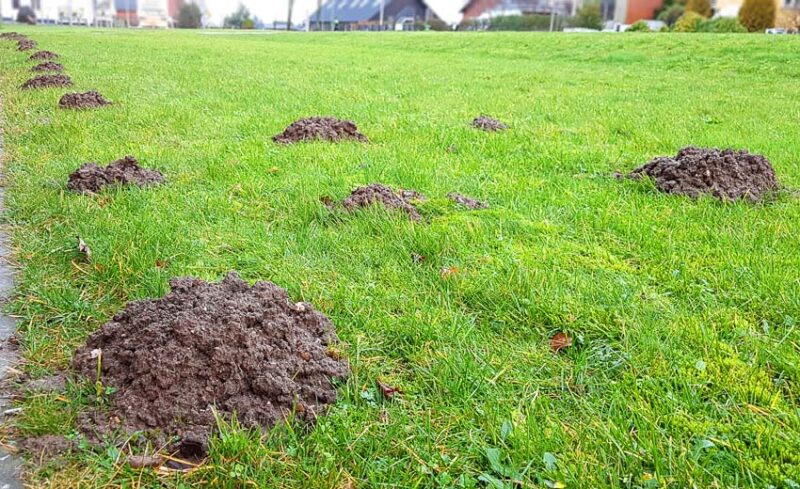
One of the easiest ways to tell if you have moles is the circular mounds of dirt they leave behind when they push dirt out of their tunnel.
It’s easy to mistake gopher mounds for molehills. The easiest way to tell them apart is that molehills are round and volcano-shaped, while gopher mounds are shaped like kidneys, horseshoes, crescents, or fans.
The hunting tunnels made by moles are shallow because they feed on the grubs living in the root zone. You can often see a raised ridge above their path.
These tunnels make the ground soft and spongy, and they collapse when you step on them. If the mole is active, you will see a fresh mound of dirt where the tunnel was repaired.
Recognizing the Common Indicators of a Vole Presence
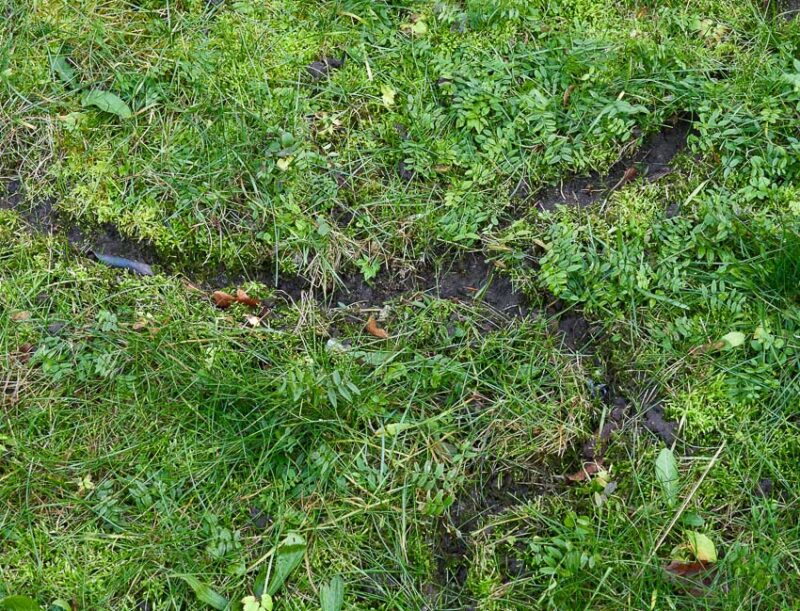
Voles are more likely to create surface tunnels in plant debris, and if they do use tunnels, they tend to use established mole tunnels. Vole damage looks more like cracks or tunnels on the surface of your lawn and garden.
Sometimes you will see vole tunnels if you lift up mulch.
Voles eat tree bark and cause significant damage to trees, including young saplings and mature trees, by girdling them. Girdling kills trees because the bark is removed from the entire circumference of the tree.
Rabbits are sometimes the culprits, but vole girdling is easy to recognize by the smaller chew marks, which are about ⅛” long and irregular. Conversely, rabbit gnaw marks are larger and are usually higher off the ground.
When the snow melts in the spring, it’s easy to see the maze of surface tunnels that voles have made.
Throughout the season, they maintain tunnels in vegetation by keeping the grass trimmed in their path but allowing it to grow over the top to provide protection from predators. These tunnels are about 1.5 inches wide.
Vole nests are about 6 to 8 inches in diameter, and globular, usually made of dried grass and twigs. You can often find them under old logs or boards or pieces of scrap metal.
Getting Rid of Moles and Voles: Effective Strategies
It may not be realistic to expect to remove moles and voles from your entire property. These animals are widespread, and as soon as you eradicate one, another will take over the territory they leave behind.
Concentrating on specific areas, like your vegetable garden and lawn, is more feasible.
Safe and Humane Methods to Control Moles
Exclusion is one of the most effective methods for controlling moles. You can fence off an area to keep moles from tunneling underneath your garden, and then focus eradication methods inside the fenced area.
Dig a trench about one foot deep by one foot wide. Bend a 24-inch piece of metal into an L shape, and place the metal into the trench with the bottom of the L facing away from the area you are fencing.
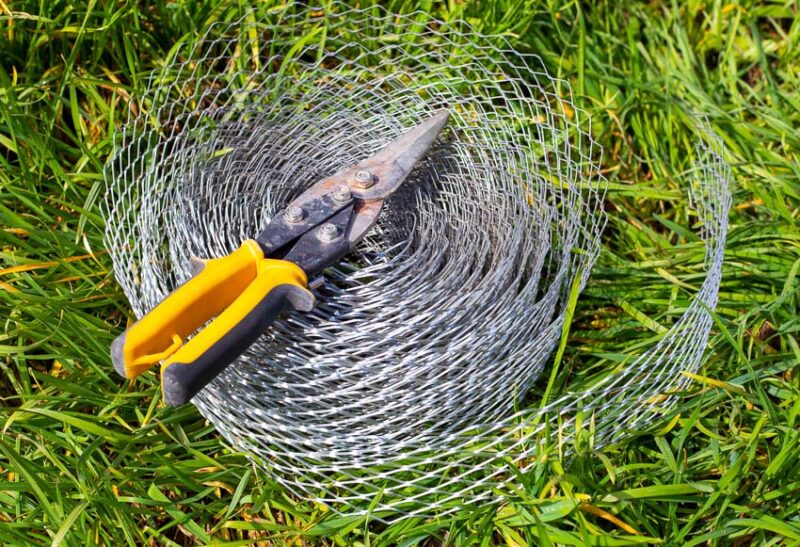
As an alternative, you can also use rolls of reinforced metal mesh.
Repellents are also effective methods for getting rid of moles. Spray castor oil around the perimeter of your lawn and garden to keep moles away. You can also plant marigolds and mole plants (Euphorbia latharis) around the perimeter of your garden.
Indirect control methods for moles may also be effective. If you have a severe mole problem in your lawn, it can indicate the presence of grubs. Learn how to get rid of grubs to avoid attracting moles to your yard.
Strategies for Managing Voles in Your Garden
Poisoning voles can present hazards to their natural predators, so it’s not recommended. Repellents and preventive strategies are the most effective strategies for managing voles in your garden.
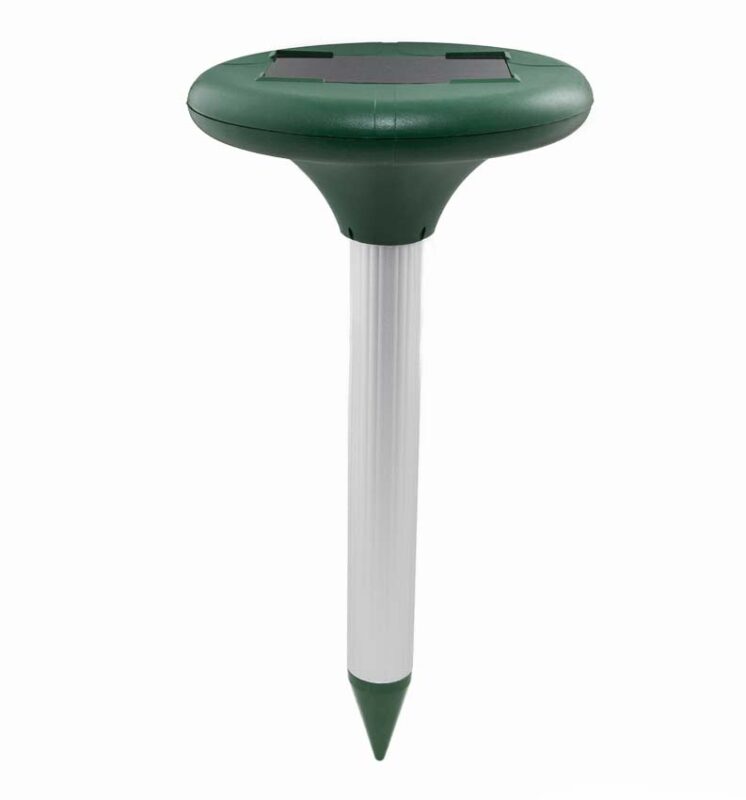
You can purchase vole and mole repellents, such as sprays, granules, and ultrasonic deterrent devices . Castor oil is also effective against voles, moles, and other pests.
Keep your yard free of debris and neatly trimmed so that voles can’t make surface tunnels or nests. You can also prevent damage caused by voles by using ¼” hardware cloth around the base of trees to prevent girdling.
Moles and Voles FAQs
Q1: Are Moles and Voles Dangerous to Humans?
Moles and voles aren’t generally dangerous to humans, but the diseases they carry can be. Although rare, they have been known to carry rabies, which is transmissible to humans. They are also hosts for pests like ticks and fleas, which carry diseases that are dangerous to humans.
Q2: Do Moles and Voles Damage Garden Plants?
Moles and voles both cause damage to lawns and garden plants. Moles, primarily insectivorous, damage your lawn and garden by digging tunnels and creating fresh mounds of dirt. Voles use surface tunnels or established mole tunnels to move around, but they cause significant damage to plants by eating them.
Q3: Can Moles and Voles Coexist in the Same Garden?
Moles and voles often coexist in the same territory. In fact, you can have moles, voles, shrews, and gophers in your yard. It can be confusing trying to figure out which animal is causing the most damage.
Q4: What Attracts Moles and Voles to My Garden?
Moles eat insects and grubs, and their favorite food is earthworms. They like to dig in soft, moist dirt that is full of worms and insects. Voles are attracted to all types of plants and food sources, and they like to use mole tunnels and hide in tall grass.
Q5: Are there Natural Predators for Moles and Voles?
As small animals, moles and voles have many natural predators. Coyotes, foxes, badgers, weasels, cats, and birds of prey, such as hawks and owls, all hunt for moles and voles.

